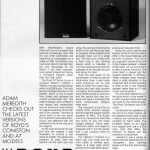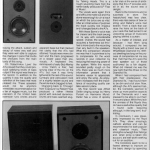Reproduced from Hi-Fi Review November/December 1987.
THE ROYD ALTERNATIVE
ADAM MEREDITH CHECKS OUT THE LATEST VERSIONS OF ROYD’S CONISTON AND A7 MODELSWith Wharfedale’s recent Diamond III price increase it has become increasingly clear that the sub £100 contenders are beginning to congregate on a ledge at £99. Goodmans may have been able to maintain their low cost advantage for the Maxim II but other manufacturers prefer to take their money in increased margins rather than from high sales.
The Royd A7 Series IIs are a compact, 305mm x 203mm x 190mm, two-way ported design which cost £99 a pair. The most obvious change has been in the tweeter, which is now a model from Audax and replaces the original purple/violet unit. The bass/midrange unit is of Royd’s own design and construction and an aluminium tube braces its magnet assembly to the rear wall of the cabinet. The tube is glued firmly to the rear panel but, to allow for removal and servicing, only attached with soft adhesive to the ferrite ring lip of the magnet.
As the tube encloses the rear port and the magnet it was necessary to include a slot along its length. This allows the pressure to pass from the cabinet into the room and vice versa. By carefully choosing the width of the slot Royd are able to squeeze some powerful and accurate bass out of a small box. The rear port is fitted with a foam ring or anti chuffing device which is intended to minimise noises arising from the passage of air through the port and along the tube.
Royd are well aware of the advantages of keeping cabinet dimensions down. A well made small enclosure will be less likely to suffer from panel resonances and may reap benefits in imaging. Such speakers often have simple crossover networks and the results that they produce can have a liveliness that more complicated designs often miss.
The crossover in the A7s is a simple three element design which brings the tweeter into the equation at 4kHz. The Audax unit is an inexpensive item that has found its way into many budget designs. Some manufacturers seem over-eager to dispense with it but the results that it can produce belie its cheapness.
The cabinet is finished in a black ash vinyl wrap and the front baffle is painted grey. There is a foam grille which proved to be sufficiently acoustically transparent to be left in place although the ‘naked’ speaker looks good too. These speakers are designed as bookshelf units but benefits are to be had if they are firmly mounted on well designed speaker stands.
The Royd Conistons present something of a problem as they so closely resemble the A7s that a second glance is required to distinguish between them.
Using the same cabinet and tweeter as the A7 the Conistons differ in the bass/midrange unit and the crossover. This unit is an ‘upgraded’ version of the one in the cheaper speaker. Instead of the foam roll surround there is now a rubber surround. The cone itself is doped and the magnet assembly is different. These changes have necessitated a slight alteration to the crossover and so the Coniston is likely to be a very different speaker rather than an A7 with a new unit bunged in.
The only other difference is in the grille which in this model is a cloth covered frame and was not used for the listening tests. The Royd Conistons cost £125 a pair.
I auditioned the speakers on the end of my home system. All the speakers were used on Kan II stands and connected to the amplifier by Naim cable. The turntable rested on an Origin Live support and I sat in a 60’s vinyl chair that offers the minimum of beauty with the maximum of discomfort.
I elected to use a variety of tracks from the Alpha Blondy LP ‘Jerusalem’, and listening began with the A7s and the title track.
The sound was immediately attractive and I knew that I wasn’t going to be forced to endure a few hours of torture while listening to these speakers. Vocals were clear and moving and treble detail was remarkable. The bass was tuneful and had fair extension although the speakers never produced any bass sounds lower than those that they could control. The sound spread between the speakers with good imaging whilethe character was of precision without over-analysis.
‘I Love Paris’ showed the speakers to be capable of portraying the attack, sustain and decay of notes very well and they were well able to capture the changes in pace that divide the choruses from the main body of this song.
On ‘Kalachnikov Love’ the A7s proved that they could produce satisfying levels of bass output if the signal was there on the record. In addition to the quantity it was the quality and definition of the bass that most pleased me. These speakers would not be anyone’s immediate recommendation for a fan of reggae music, but the precision of the limited bass extension runs circles around the indistinct wafflings of most classic reggae systems.
Comparing this track on the Conistons showed almost all the differences that were to be discovered later. It was instantly noticeable that there was more apparent bass but that it lacked the clarity that the A7s had attained. Vocals were more distant and the track progressed at a slower pace than previously. A keyboard line, reminiscent of early Bob Marley – circa ‘Catch a Fire’, had sprung clear of the mix on the A7s, but now it was firmly tethered tothe rest of the sound. Cymbals and percussion took on a slightly leaden sound and the whole track dragged its feet.
Changing back to ‘Chicago’ from ‘Exposure’ by Robert Fripp produced a rather lifeless sound with reduced dynamics. Drums and bass seemed sluggish and there was no menace in the song. Returning to the A7s opened things out immensely and the pace and excitement was restored. Vocals were now articulate and it was difficult to see how the price differential could be justified.
As the Conistons seemed the more polite of the speakers I tried them with ‘Life in Wartime’ by Talking Heads. This is a rough sounding track from the rather badly produced LP ‘Fear of Music’.
The vocals were again thick and difficult to make out and this alone was enough to ruin atrack on which the lyrics are so vital. After an initial sense of purpose the track quickly lost impetus and I changed back to the A7s.
With these Byrne’s voice was far clearer and the track swung on its way with considerable speed. Overall, the sound had acquired a harshness but this I feel is more duetothe recording than any fault in the speakers. What this comparison showed me was that it is pointless to try to compensate for the worst records in your collection by reducing the resolving power of the system. While this record sounded pretty rough on the A7s, there was so much more information present that it became easier to appreciate and enjoy the song. As enjoyment increases then the importance of recording quality can take second place.
My final record was Alfred Deller singing songs by Henry Purcell on Harmonia Mundi. Deller has a voice of spooky purity which stands clear of the accompanying instruments and is projected into the room. The A7s took this track, ‘Music for a While’, well in their stride. lt seemed to show the speakers in their best light – Deller’s voice soared above the delicate harpsichord play and the bowed bass was clear and raspy. Also, the speakers made a fair stab at the sense of ambience that this LP provides and, all in all, the sound was a delight.
Back to the Conistons and no surprises in store. The harpsichord was less clear, there was less sense of bow on string and Deller’s voice had broken. From a track that can raise the hairs on the back of your neck this had turned to an unexciting group of musicians playing behind a curtain.
As a matter of interest, and because I had them lying around, I ‘compared the two Royds with a brand new pair of Wharfedale Diamond IIIs. without dwelling too long on the process of comparison let me say that I felt that the A7s were the best speaker out of those auditioned by a fair degree. What did interest me was the new light that this threw on the Diamond IIIs.
When I had compared them with their predecessor, the Diamond IIs, I had found them to be dim and a bit slow. Now, although the A7s seemed better, the Conistons seemed to show up more positive aspects of the Diamonds and I was pleased to be able to put them in second place. Whilethey lack the airiness of the Royds they do have a seductive quality that I found quite beguiling although, in the long term, frustrating.
In conclusion, I was pleasantly impressed by the Royd A7s. They show amazingly catholic abilities and can be recommended for both popular and classical music. Their strengths outweigh their failings and, when price is taken into account, are well worth seeking out for an audition.
The Conistons seem to be a flawed attempt to improve on the basic design by spending more on the bass/midrange unit. I suspect that the A7s appealing liveliness stems in part from its lighter and more responsive unit and that the compromises that it embodies are the best that can be had without a more radical set of alterations. At the price it cannot be recommended but do give its baby brother a listen.
Reprinted from “Hi-Fi Reivew” November/December 1987

